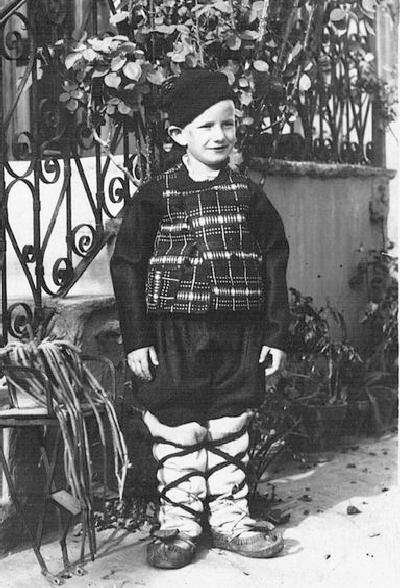
Figure 1.--This 7-year-old Bulgarian boy, Mitko, had his photograph taken in 1939. He is wearing a traditional costume for some kind of special occassion. He was from Sliven. Notice the cap and leggings. |

|
Bulgaria has some destinctive folk fashions, similar in many ways to neighboring Greece and other Bakan countries. I am not positive about the influenes here, but several centuries of Ottomon rule must have been a factor. This probably is a factor in some common elements in Balkan folk costumes. Folk outfits for boys and men include pants, shirts, and vests for men. A common feature for boys and men was a kind of leggings. Women and girls wear decorative aprons and dresses. The girls' aprons and dresses boys' shirts are commonly embroidered in bright colors. The various regions used destinctive colors and motifs. Red is an especially important color in Bulgarian folk wear. Other colors such as black, green, and white are also important and vary regionally. Children in rural areas were still wearing traditional dress as ordinary clothes in the early 20th century while standard European styles were more common in towns and cities. These dfolk outfits disappeared as commpon dress after World War II. As in many other European countries we see city boys in the early 20th century being dressed up in traditional costumes for photographs. Today traditional styles are worn for special events and festivals.
Bulgaria has some destinctive folk fashions, similar in many ways to neighboring Greece and other Bakan countries. I am not positive about the influenes here, but several centuries of Ottomon rule must have been a factor. This probably is a factor in some common elements in Balkan folk costumes.
Folk outfits for boys and men include pants, shirts, and vests for men. A common feature for boys and men was a kind of leggings. Women and girls wear decorative aprons and dresses. The girls' aprons and dresses boys' shirts are commonly embroidered in bright colors. Footwear verried. We note men wearing leggings. We also notice men and boys wearing sandals and girls and women strap shoes.
The various regions used destinctive colors and motifs.
Red is an especially important color in Bulgarian folk wear. Other colors such as black, green, and white are also important and vary regionally.
Children in rural areas were still wearing traditional dress as ordinary clothes in the early 20th century while standard European styles were more common in towns and cities. These folk outfits disappeared as common dress after World War II.
As in many other European countries we see city boys in the early 20th century being dressed up in traditional costumes for photographs. As far as we know, taking these nostalgic images declined after the Communist takeovef following World War II.
People would dress up in their best outfits for important village festivals. We do not have a lot of information on these festivals. We believe most were related to the annual celebration of the village saint. Harvest festivals were also common. Today traditional styles are also commonly worn for village festivals as well as other special events.
We have only limited information on Bulgarian choral groups. They had a variety of costumes. We notice one which uses folk costumes--the folk ensemble "Bulgarche" which was was founded in 1968. The founder and Chief-Art Director is Mr. Michail Minchev Djlgerov. About 300 young people participate in various ways. While they sing choral music, they also have an orchestra and dance group. The roup's repertoire includes folk dances, songs and orchestral pieces. They are csareful to include material from all etnographic regions of the country. They have performed all over Bulgaria as well as in many foreign countries. The group describes itself, "Bulgarche -- a personification of the Bulgarian spirit for health, strength, beauty and youth. Behind this name you will discover the youthful and bright smiles on child`s faces. In their clear, open eyes you can read the carefree freedom of happy childhood, the whiff of lovely, native Balkan fields, the sun of Bulgaria and the pride of its old capital - Turnovgrad - a witness of ancient history and culture. It`s enought to see them just once and you will always remember: their motley coloured magnificent folk costumes shining with beauty and dyes, interwoven with love and feeling that has outlived time."
Navigate the Boys' Historical Clothing Web Site:
[Introduction]
[Activities]
[Biographies]
[Chronology]
[Clothing styles]
[Countries]
[Bibliographies]
[Contributions]
[FAQs]
[Glossary]
[Images]
[Links]
[Registration]
[Tools]
[Boys' Clothing Home]
Navigate the Boys' Historical Clothing national pages:
[Return to the Main Bulgarian page]
[Return to the Main European page]
[Albania]
[Austria]
[Bosnia]
[Croatia]
[Hungary]
[Romania]
[Serbia]
[Slovenia]
[Australia]
[Belgium]
[England]
[France]
[Germany]
[Ireland]
[Italy]
[Japan]
[Korea]
[Mexico]
[New Zealand]
[Scotland]
[United States]
Navigate the Boys' Historical Clothing Bulgarian pages:
[Return to the Main Bulgarian page]
[Bulgarian choirs]
[Bulgarian royalty]
[European youth groups]
